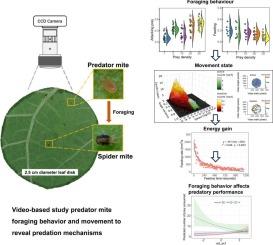不同猎物密度下双尾新绥螨觅食行为与食性增益的关系
IF 3.4
2区 农林科学
Q2 BIOTECHNOLOGY & APPLIED MICROBIOLOGY
引用次数: 0
摘要
觅食行为决定了天敌的捕食能力和生物防治效果。猎物密度显著影响它们的觅食行为。通过对不同猎物密度下捕食者觅食行为的运动过程分析,揭示了捕食者通过能量投入和能量回报的觅食机制。捕食性螨bicaudus (Neoseiulus bicaudus)捕食土耳其叶螨(Tetranychus turkestani Ugarov et Nikolskii)等害虫(螨目:叶螨科)。通过视频跟踪,我们评估了突厥斯坦夜蛾的密度(每个竞技场0、1、5、10、20和30只)如何影响二头圆尾夜蛾的觅食行为、运动和能量获取。本研究探讨了猎物密度对捕食能力影响的行为机制,并从行为角度评价了生物防治优化。猎物密度显著影响双头小鲵的觅食行为,攻击频率在30个猎物时达到峰值。行为之间的时间分配在不同密度之间保持不变。使用机器学习算法(基于速度和转弯角度参数)的运动分析揭示了两种不同的运动状态:活跃和不活跃。在10个猎物以下,非活动状态占主导地位;较高的密度有利于活性态。非活动状态显著影响攻击频率和猎物消耗;捕食率进一步受到运动状态相互作用的调节。能量增益与非活动状态持续时间显著相关。高的猎物密度减少了每只猎物的摄食时间,但增加了总能量增益,延长了斑块停留时间。双头新绥虫对猎物密度动态调节捕食频率和运动状态。运动状态可能是影响捕食效率的关键因素,这与最优觅食理论的预测一致。这种对捕食者-猎物相互作用的机制理解为优化基于天敌的生物防治策略提供了一个框架。本文章由计算机程序翻译,如有差异,请以英文原文为准。

Relationship between foraging behavior and predatory gain of Neoseiulus bicaudus under different prey densities
Foraging behavior determines natural enemies’ predation capacity and biological control efficacy. Prey density significantly affects their foraging behavior. Studying predator foraging under different prey densities with movement process analysis reveals foraging mechanisms through energy investment and return. The predatory mite Neoseiulus bicaudus (Wainstein) (Acari: Phytoseiidae) preys on pests including Tetranychus turkestani Ugarov et Nikolskii (Acari: Tetranychidae). Using video-tracking, we evaluated how T. turkestani densities (0, 1, 5, 10, 20, 30 per arena) affect N. bicaudus foraging behavior, movement, and energy gain. This research investigates behavioral mechanisms underlying prey density effects on predation capacity and evaluates biocontrol optimization from a behavioral perspective.
Prey density significantly impacted N. bicaudus foraging, with attack frequency peaking at 30 prey. Time allocation among behaviors remained constant across densities. Movement analysis using machine learning algorithms (based on speed and turning angle parameters) revealed two distinct movement states: active and inactive. Below 10 prey, inactive states dominated; higher densities favored active states. Inactive states significantly affected attack frequency and prey consumption; predation rates were further modulated by movement states interactions. Energy gain correlated significantly with inactive-state duration. High prey densities decreased per-prey feeding duration but increased total energy gain and extended patch residence time.
Neoseiulus bicaudus dynamically regulates predation frequency and locomotor states in response to prey density. Movement states may be the key factor influencing predation efficiency, consistent with optimal foraging theory predictions. This mechanistic understanding of predator–prey interactions provides a framework for optimizing natural enemy-based biocontrol strategies.
求助全文
通过发布文献求助,成功后即可免费获取论文全文。
去求助
来源期刊

Biological Control
生物-昆虫学
CiteScore
7.40
自引率
7.10%
发文量
220
审稿时长
63 days
期刊介绍:
Biological control is an environmentally sound and effective means of reducing or mitigating pests and pest effects through the use of natural enemies. The aim of Biological Control is to promote this science and technology through publication of original research articles and reviews of research and theory. The journal devotes a section to reports on biotechnologies dealing with the elucidation and use of genes or gene products for the enhancement of biological control agents.
The journal encompasses biological control of viral, microbial, nematode, insect, mite, weed, and vertebrate pests in agriculture, aquatic, forest, natural resource, stored product, and urban environments. Biological control of arthropod pests of human and domestic animals is also included. Ecological, molecular, and biotechnological approaches to the understanding of biological control are welcome.
 求助内容:
求助内容: 应助结果提醒方式:
应助结果提醒方式:


